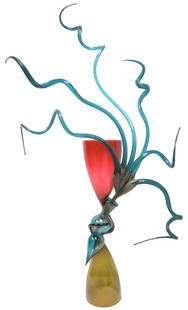
A RARE AND IMPORTANT 19TH CENTURY AMERICAN CARVED MARBLE FIGURE entitled The Infant Bather, by Marg
Similar Sale History
View More Items in Sculptures & CarvingsRelated Sculptures & Carvings
More Items in American Sculptures & Carvings
View MoreRecommended Art
View More
















Item Details
Description
A RARE AND IMPORTANT 19TH CENTURY AMERICAN CARVED MARBLE FIGURE entitled The Infant Bather, by Margaret Foley (1827-1877) the well formed figure modelled with hands clasped, upon a naturalistic base, signed Margaret Foley Sc Roma 1873). 90cm x 22cm. Note: In Rome, Foley began to sculpt large marble medallion portraits?for example, a portrait of the poet William Cullen Bryant?as well as portrait busts in the round, such as the 1877 bust of the Transcendentalist minister Theodore Parker. One of her most well-known medallions, created in 1866, depicted Pascuccia, a model from Naples renowned for her beauty. With a Christian cross at her neck and Semitic features, Pascuccia embodied the polyglot world of nineteenth-century Rome, and Foley sold at least four versions of the sculpture. Foley also sculpted biblical and historical subjects such as Jeremiah and Cleopatra, both of which were exhibited at the main Memorial Hall of the 1876 Philadelphia Centennial Exposition. Foley also exhibited a large fountain at the Exposition's Horticultural Hall, consisting of three children supporting a marble basin adorned with acanthus leaves (now in the Fairmount Park Horticultural Center in Philadelphia, Pennsylvania). Over the course of her career, she gained many commissions and praise for her "crisply delineated, noble style". The qualities that enabled Margaret Foley to transform herself from a small-town New England school teacher to a Boston sculptor proved equally effective in Rome. As Foley set about establishing herself, she continued to produce cameos and medallions for a succession of patrons who prized her work. Through her friendship with Harriet Hosmer, she met John Gibson (1790?1866), the eminent Welsh Neoclassical sculptor resident in Rome, who had earlier mentored Hosmer. Gibson was a member of the Royal Academy in London and had initially been a prot?g? of the famous Neoclassical Italian sculptor, Antonio Canova (1757?1822). Gibson was immediately impressed with Foley?s work and offered her encouragement and guidance. Foley carefully positioned herself to be able to produce ideal pieces as well as portraits. From her vantage point in Rome, Foley managed an active schedule of international exhibitions, sending marble busts and bas-reliefs to London, Dublin, and Paris, as well as New York City and Philadelphia. It has been suggest this may be a commission or the original study for the marble fountain for the Horticultural hall at the Philadelphia Centennial Exposition of 1876, as this present figure is dated 1873. Her monumental marble fountain, known as Miss Foley?s Fountain, was exhibited separately, as the prominent centrepiece in the Horticultural Hall. This sculpture depicted three life-size children shaded by a covering of acanthus leaves in which rested a basin. Designed by the architect H.J. Schwarzmann (1846-1891), the Horticultural Hall was the smallest of the five Centennial structures ?but it was the largest conservatory built up to that time, bigger than the famous hothouses in the Botanical Gardens of London and Paris. Like Foley?s sculpture within it, the structure?s Moresque style received both professional and public praise, however, the success of the exhibition never led to any immediate further patronage for Foley. The Horticultural Hall itself was demolished in 1955, though the fountain still resides in Philadelphia within the same site now called the Fairmount Park Horticultural Centre. Her funds depleted and her health failing, she returned to Europe where she was taken by her friends, the Howitts, to Austria to recuperate, but she died of a stroke in Meran, Austria, in 1877. Note a similar study resides in the Novelli room Palermo, it was inherited by the Filangeri family by the will of the Marquise of Torrersa, During the studies carried out on the work during the restoration of this particular figure, it was discovered that it is the sketch, slightly smaller in size than the final work, of one of the three statues of "Bathers" designed for a fountain to be presented at the Exhibition of Philadelphia from 1878. The infant bather is one of 5 produced by Foley in the 1870s, 4 of which resided in private hands (one of which being this example) the other is known to have been destroyed.
Buyer's Premium
- 28%
A RARE AND IMPORTANT 19TH CENTURY AMERICAN CARVED MARBLE FIGURE entitled The Infant Bather, by Marg
Estimate £1,000 - £1,500
5 bidders are watching this item.
Shipping & Pickup Options
Item located in Selborne, Hampshire , ukOffers In-House Shipping
Local Pickup Available
Payment

TOP





















































































